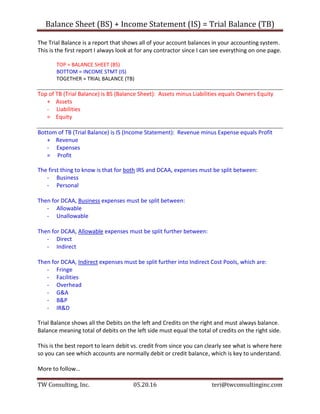BS + IS = TB
•
0 likes•149 views
The trial balance is a report that shows all account balances and must balance with debits equaling credits. It contains the balance sheet at the top, with assets minus liabilities equaling equity, and the income statement at the bottom, with revenue minus expenses equaling profit. For accounting and auditing purposes, expenses must be classified as business or personal, and business expenses further split into allowable, unallowable, direct or indirect categories. The trial balance provides a comprehensive overview of a company's financial reporting.
Report
Share
Report
Share
Download to read offline

Recommended
Recommended
More Related Content
Similar to BS + IS = TB
Similar to BS + IS = TB (20)
How to Prepare "Statement of Financial Position" Tutorial

How to Prepare "Statement of Financial Position" Tutorial
A C C O U N T I N G F O R N O N C O M M E R C E S T U D E N T S

A C C O U N T I N G F O R N O N C O M M E R C E S T U D E N T S
BS + IS = TB
- 1. Balance Sheet (BS) + Income Statement (IS) = Trial Balance (TB) TW Consulting, Inc. 05.20.16 teri@twconsultinginc.com The Trial Balance is a report that shows all of your account balances in your accounting system. This is the first report I always look at for any contractor since I can see everything on one page. TOP = BALANCE SHEET (BS) BOTTOM = INCOME STMT (IS) TOGETHER = TRIAL BALANCE (TB) Top of TB (Trial Balance) is BS (Balance Sheet): Assets minus Liabilities equals Owners Equity + Assets - Liabilities = Equity Bottom of TB (Trial Balance) is IS (Income Statement): Revenue minus Expense equals Profit + Revenue - Expenses = Profit The first thing to know is that for both IRS and DCAA, expenses must be split between: - Business - Personal Then for DCAA, Business expenses must be split between: - Allowable - Unallowable Then for DCAA, Allowable expenses must be split further between: - Direct - Indirect Then for DCAA, Indirect expenses must be split further into Indirect Cost Pools, which are: - Fringe - Facilities - Overhead - G&A - B&P - IR&D Trial Balance shows all the Debits on the left and Credits on the right and must always balance. Balance meaning total of debits on the left side must equal the total of credits on the right side. This is the best report to learn debit vs. credit from since you can clearly see what is where here so you can see which accounts are normally debit or credit balance, which is key to understand. More to follow…